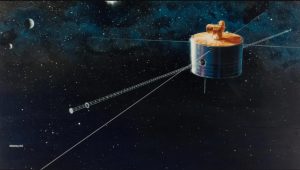
NASA-JAXA Geotail spacecraft
After 30 years in orbit mission, NASA–JAXA Geotail spacecraft have signed off, after the failure of the spacecraft’s remaining data recorder. Since its launch on July 24, 1992, Geotail orbited Earth, gathering an immense dataset on the structure and dynamics of the magnetosphere, Earth’s protective magnetic bubble. The spacecraft was originally slated for a four-year run, but the mission was extended several times due to its high-quality data return, which contributed to over a thousand scientific publications.
Buy Prime Test Series for all Banking, SSC, Insurance & other exams
The orbit of Geotail took the spacecraft over 1,93,121 kilometres away from Earth. The spacecraft also provided scientists with complimentary data from remote parts of the magnetosphere. This helped scientists obtain a glimpse of how events seen in one area affect other regions. Geotail’s findings, combined with observations on the ground, helped scientists confirm the location and mechanisms of how auroras form.
Why Geotail spacecraft signed off?
The mission operations for Geotail ended after the failure of the spacecraft’s remaining data recorder. One of Geotail’s two recorders failed in 2012. However, the second recorder continued to work until experiencing an anomaly on June 28, 2022. Attempts were made to remotely repair the recorder, but in vain. On November 28, 2022, the mission operations for Geotail were ended.
Why this mission stretched many times?
- Geotail revolved around Earth in an elongated orbit, and sailed through the invisible boundaries of the magnetosphere. The satellite gathered data on the physical processes at play in the magnetosphere to help understand how the flow of energy and particles from the Sun reach Earth.
- Some of the scientific breakthroughs achieved by Geotail include helping scientists understand how quickly material from the Sun passes into the magnetosphere, identifying oxygen, aluminium, sodium, and silicon in the lunar atmosphere, and finding clues about the physical processes at play at the magnetosphere’s boundary.
- With the help of the Geotail mission, scientists identified the location of a process called magnetic reconnection, which is a major conveyor of material and energy from the Sun into the magnetosphere. Magnetic reconnection is one of the factors responsible for instigating auroras.
Important takeaways for all competitive exams:
- NASA Headquarters: Washington, D.C., United States;
- NASA Founded: 29 July 1958, United States;
- NASA Founder: Dwight D. Eisenhower;
- NASA Administrator Bill Nelson;
- Japan Aerospace Exploration Agency Head: Hiroshi Yamakawa;
- Japan Aerospace Exploration Agency Founded: 1 October 2003;
- Japan Aerospace Exploration Agency Headquarters: Tokyo, Japan.
You may also read this:
- NASA’s James Webb Space Telescope Discovers New Exoplanet Named LHS 475b
- NASA named Indian-American space expert AC Charania as chief technologist




 Deepinder Goyal Tops Hurun Rich List 202...
Deepinder Goyal Tops Hurun Rich List 202...
 Indian Team Bags Global Top Honour at NA...
Indian Team Bags Global Top Honour at NA...
 India’s Net Direct Tax Collections Rise ...
India’s Net Direct Tax Collections Rise ...







